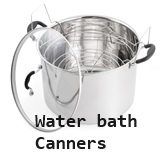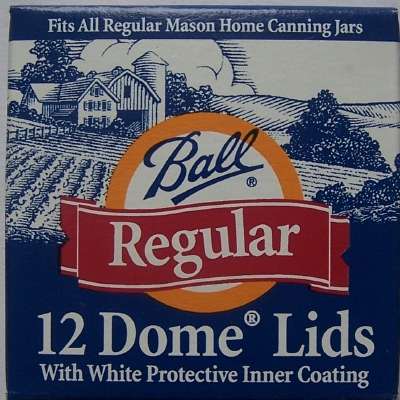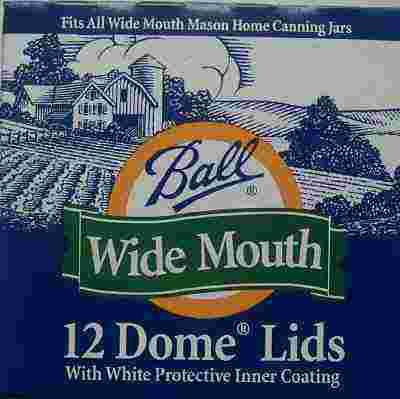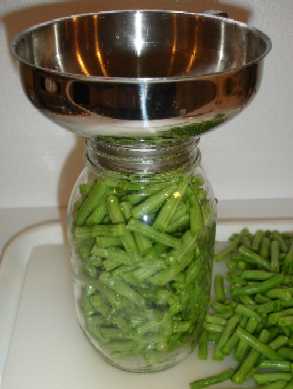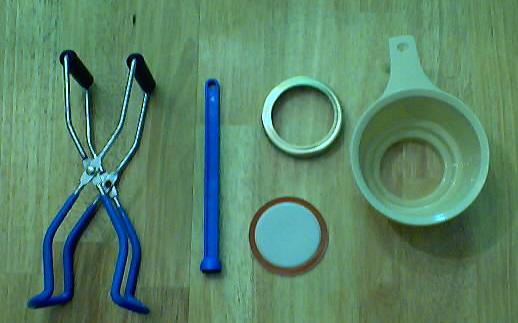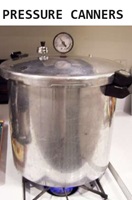
Looking for Making Homemade Pickled Dilled Green Beans in 2025? Scroll down this page and follow the links. And if you bring home some fruit or vegetables and want to can, freeze, make jam, salsa or pickles, see this page for simple, reliable, illustrated canning, freezing or preserving directions. There are plenty of other related resources, click on the resources dropdown above. If you are having a hard time finding canning lids, I've used these, and they're a great price & ship in 2 days.
If you have questions or feedback, please let me know! There are affiliate links on this page. Read our disclosure policy to learn more.
Making Homemade Pickled Dilled Green Beans
Making Homemade Pickled Dilled Green Beans
Making and canning your own pickled dilled green beans is one of the easiest things you can do with your green beans to preserve it for later use! Here's how to do it, in easy steps and completely illustrated. This method is so easy, ANYONE can do this! It yields 8 to 9 pints.
Ingredients
- 4 lbs fresh tender green or yellow beans (5 to 6 inches long) - fresh, firm - not wilted, soft or overripe!
- 8 to 16 heads fresh dill (in a pinch, you can substitute 4 teaspoons of dill seed)
- 1/2 cup canning or pickling salt
- 4 cups water
- 4 cups vinegar (5%, white vinegar is best, apple cider vinegar also works well). Store brand is about $1.25 for a 64 oz bottle.
- 8 to 9 garlic cloves (optional)
- 1 teaspoon hot red pepper flakes (optional) or 6 small hot peppers (optional)
Equipment
- 1 water bath canner (a huge pot to sanitize the jars after filling (about $30 to $35 at mall kitchen stores, sometimes at big box stores and grocery stores.). Note: we sell many sizes and types of canners for all types of stoves and needs - see canning supplies - you can also use a Pressure Canner.
- Quart or pint canning jars (Ball or Kerr jars can be found at grocery stores, like Safeway, Publix, Kroger, grocery stores, even online - about $13 per dozen 8-ounce jars, more for quilted design or larger jars, including the lids and rings).
- Lids - thin, flat, round metal lids with a gum binder that seals them against the top of the jar. They may only be used once.
- Rings - metal bands that secure the lids to the jars. They may be reused many times.
- Jar funnel ($5 at Target, other big box stores, and often grocery stores; and available online - see this page)
- 1 large pot; Nonstick ceramic coated pots for easy cleanup.
- Large spoons and ladles,
- Jar grabber (to pick up the hot jars)
- Lid lifter (I like the lid rack that holds 12 lids or you can pull them out one at a time with the lid-lifter that has a magnet from the almost-boiling water where you sanitize them. ($4 at Target, other big box stores, and often grocery stores; and available online - see this page)
Process - How to Make Pickled Green Beans
Step 1 - Selecting the green beans
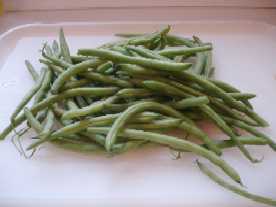 It's
fun to go pick your own and you can obviously get better quality green
beans!
It's
fun to go pick your own and you can obviously get better quality green
beans!
At left is a of picture green beans from my garden - it is SO easy to grow.
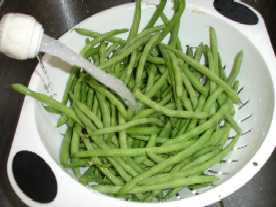
Step 2 - How many green beans?
It takes about 1/2 lb of green beans to fill a pint jar.
Step 3 -Wash and cut the green beans!
I'm sure you can figure out how to wash the fruit in plain cold water.
You will need to cut the ends off (about 1/4-inch).
Step 4 - Get the jars and lids sanitizing
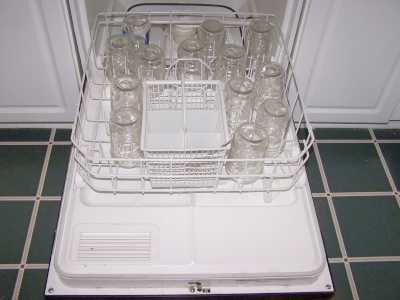 The
dishwasher is fine for the jars; especially if it has a "sanitize" cycle.
I get that going while I'm preparing everything else, so it's done by the
time I'm ready to fill the jars. Be sure to let it go through the rinse
cycle to get rid of any soap! It's also a good time to start heating
up the water in the canner and the small pan of water to warm the lids to soften the adhesive.
The
dishwasher is fine for the jars; especially if it has a "sanitize" cycle.
I get that going while I'm preparing everything else, so it's done by the
time I'm ready to fill the jars. Be sure to let it go through the rinse
cycle to get rid of any soap! It's also a good time to start heating
up the water in the canner and the small pan of water to warm the lids to soften the adhesive.
Lids: put the very hot (but not quite boiling; around 180 F,
steaming water is fine)
water for at least several minutes. Note:
everything gets sanitized in the water bath (step 7) anyway, so this just
helps to ensure there is no spoilage later!)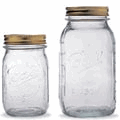
Need lids, rings and replacement jars?
Get them all here, delivered direct to your home, at the best prices on the internet!
Step 5 - Fill the jars with green beans
Fill jars firmly with whole green beans, leaving 1/2-inch headspace. Note: you can use quart or pint jars; this recipe assumes quart jars are used.
Step 6 - Trim the ends
Just take a sharp knife and cut of both ends (about 1/4 of an i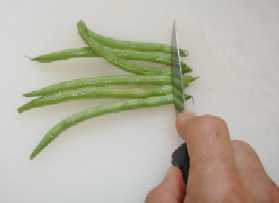 nch,
or half the width of an average woman's little finger). Then cut
them into pieces of the size you prefer, usually about 1 inch long.
nch,
or half the width of an average woman's little finger). Then cut
them into pieces of the size you prefer, usually about 1 inch long.
Norpro Deluxe Bean Frencher With Clamp
See here for related tools, equipment, supplies on Amazon
Norpro Deluxe Bean Frencher With Clamp
Of
course, if your prefer French cut green beans, you can cut the beans
lengthwise instead, or you can use a "bean Frencher". The "Frencher" enables you to prepare a huge quantity of
beans, split lengthwise, quickly!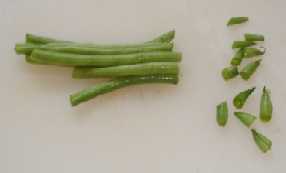
See the bottom of this page for makes, models, prices and ordering info for bean frenchers.
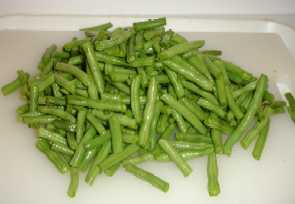
Step 7 - Packing the beans, dill (and if desired, garlic) in the canning jars
Put 1 or 2 dill heads in the bottom of each pint jar (double it for
quart jars), 1 garlic clove (optional) and then the beans (placed upright
in the jars, like pickle spears). If you are using whole small hot
peppers, you will add one each jar now.
This is called "raw packing" because we don't cook the beans before
packing them into the jars. Pack the jars fairly tightly, but be sure to
leave 1/2 inch of space at the TOP of the jar. That is called
"headspace" and is needed for expansion during heading.
Step 8 - Heat the vinegar, salt (and if desired pepper flakes) in a pot
In a pot heat the 4 cups of 5% white or cider vinegar, 4 cup of water, 1/2 cup of canning salt (or pickling salt) and, if desired to make a medium hot pickled bean, include 1 teaspoon red pepper flakes (if you want them, and didn't use the small whole hot peppers). Heat to a boil.
Step 9 - Pour the boiling vinegar solution into each packed jar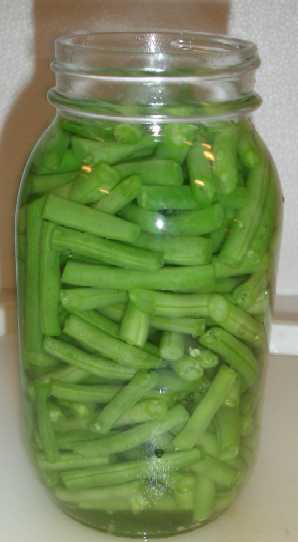
Use a ladle or pyrex measuring cup to carefully fill each packed jar with the hot vinegar solution. Fill to within 1 inch of the top. The beans should be covered and there should still be 1/2 inch of airspace left in the top of each jar. Be careful not to burn yourself, (or anyone else - children should be kept back during this step!)
Step 10 - Put the lids and rings on
Put the lids on each jar and seal them by putting a ring on and screwing it down snugly (but not with all your might, just "snug").
Step 11 - Put the jars in the canner
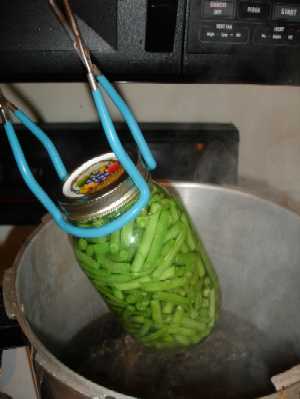 Using
the jar tongs, put the pint jars in the canner and keep them covered
with at least 1 inch of water. Keep the water boiling. Boil them for 5
minutes. Remember to adjust for altitudes and larger jars - see
the table below!
Using
the jar tongs, put the pint jars in the canner and keep them covered
with at least 1 inch of water. Keep the water boiling. Boil them for 5
minutes. Remember to adjust for altitudes and larger jars - see
the table below!
|
Processing time for Pickled Dilled Green Beans in a boiling-water canner. |
||
| Process Time at Altitudes of | ||
| 0 - 1,000 ft | 1,001 - 6,000 ft | Above 6,000 ft |
| 5 minutes | 10 minutes | 15 minutes |
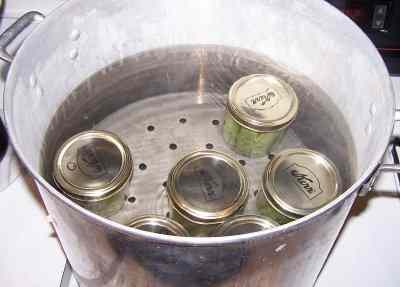
Step 12 - Done
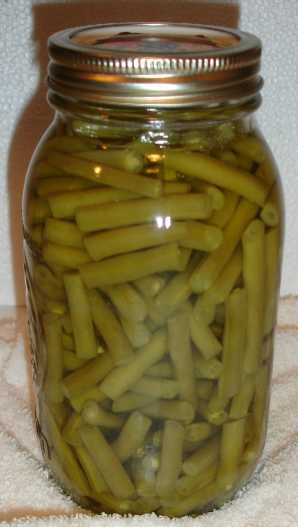 Lift
the jars out of the water and let them cool without touching or bumping
them in a draft-free place (usually takes overnight) You can then
remove the rings if you like, but if you leave them on, at least loosen
them quite a bit, so they don't rust in place due to trapped moisture.
Once the jars are cool, you can check that they are sealed verifying that
the lid has been sucked down. Just press in the center, gently, with your
finger. If it pops up and down (often making a popping sound), it is not
sealed. If you put the jar in the refrigerator right away, you can still
use it. Some people replace the lid and reprocess the jar, then that's a
bit iffy. If you heat the contents back up, re-jar them (with a new lid)
and the full time in the canner, it's usually ok.
Lift
the jars out of the water and let them cool without touching or bumping
them in a draft-free place (usually takes overnight) You can then
remove the rings if you like, but if you leave them on, at least loosen
them quite a bit, so they don't rust in place due to trapped moisture.
Once the jars are cool, you can check that they are sealed verifying that
the lid has been sucked down. Just press in the center, gently, with your
finger. If it pops up and down (often making a popping sound), it is not
sealed. If you put the jar in the refrigerator right away, you can still
use it. Some people replace the lid and reprocess the jar, then that's a
bit iffy. If you heat the contents back up, re-jar them (with a new lid)
and the full time in the canner, it's usually ok.
When can you start eating the green beans? Well, it takes some time for the seasonings to be absorbed into the pickles. Generally, that's about 2 or 3 days! Ah... the wait...
Summary - Cost of Making Homemade Pickled Green Beans - makes 8 quart jars, 16 oz each* |
||||
| Item | Quantity | Cost in 2025 | Source | Subtotal |
| Green beans | 4 lbs | free from the garden, or $3.00 cents at a PYO | Pick your own | $3.00 |
| Canning jars (quart size, wide mouth), includes lids and rings | 12 jars | $8.00/dozen | Grocery stores (Publix, Kroger, Safeway, etc.) | $8.00 |
| Vinegar | 4 cups | $0.99 | Safeway, Publix, Kroger, grocery stores |
$0.99 |
| Pickle mix | 1 packet | $3.00 per package | Grocery stores (Publix, Kroger, Safeway, etc.) | $3.00 |
| Total | $15.00 total or about $1.08 per jar INCLUDING the jars - which you can reuse! |
|||
|
* - This assumes you already have the pots, pans, ladles,, and reusable equipment. Note that you can reuse the jars! Many products are sold in jars that will take the lids and rings for canning. For example, Classico Spaghetti sauce is in quart sized jars that work with Ball and Kerr lids and rings. Note that the Classico's manufacturer does not recommend reuse of their jars: see what they have to say on this page: |
||||
How to make other pickles - recipes and instructions:
- Cucumber pickles (quick process, canned)
- Refrigerator pickles (no canning required)
- Cucumber pickle relish
- Pickled beets
- Pickled dilled okra
Canning processing times
|
Type of pickling method |
Jar size | 0 to 1,000 ft above sea level | 1,001 to 6,000 ft above sea level |
| Quick process, (raw green beans put in the jar, hot liquid poured over them)- | quart | 10 min | 15 min |
| Quick process, (raw green beans put in the jar, hot liquid poured over them)- | quart | 10 min | 15 min |
Can't find the equipment? We ship to all 50 states! Use our Feedback form!
Answers to Common Questions
What did I do wrong if my pickles aren't crisp or
crunchy?
You probably used overripe cucumbers or didn't measure the vinegar and water
accurately. Of course, processin gtoo long in the boiling water bath can do it,
too!
Why are my pickles cloudy?
There are a variety of possible causes for cloudy pickles:
In nonfermented pickles (fresh pack), cloudiness might indicate spoilage. Yeast growth may also make pickles cloudy or slimy. Check the pickles for signs of off-odors and mushiness of the pickles. If yeast growth is evident, discard the pickles. If these signs are absent, the pickles are (absent other problems) safe to eat.
Be sure to use a NON-metal pot - or a coated metal (teflon, silverstone, enamel, etc.) without breaks in the coating. the metal reacts with the vinegar and makes the pickle solution turn cloudy. This is the most common cause of cloudy pickles. There is no danger to these pickles, though!
Sometimes the fillers (anticaking agents) in regular table salt may cause slight cloudiness, so always use pickling salt. Obviously, if you used a packet mix (like Mrs. Wages) this should not be a problem.
Hard water might also cause cloudiness. If soft water is not available, boil the hard water and let it sit undisturbed overnight. Pour off the top portion and use it in the pickling solution.
Bean "Frenchers"It is tiring and laborious to prepare green beans for canning; there are so many of them and you do them all by hand. But wait there's a new device that makes it easy. Hmmm, actually, these devices have been around since our great-grandfather's day! Here are several different types and makes, some hand fed, some cranked: choose the one that meets your need and budget! For photos and features of the bean frenchers, click here!
|
Canning Books, Supplies and Accessories
These are my favorite essential canning tools, books and supplies. I've been using many of these for over 50 years of canning! The ones below on this page are just the sampling of. my preferred tools. but you can find much more detailed and extensive selections on the pages that are linked below.
- Vacuum Foodsealers for freezing, dried foods, and refrigerated foods - the FoodSaver line
- Selecting a KitchenAid mixer and attachments for home canning
- Steam Juicers
- Strainers, pit removers, seed-skin-stem removers, jelly strainers, etc. All types, makes and prices (from $19 to $350)
- Cherry pitters reviews, prices and ordering
- Food dehydrators - easy and fast to dry your own fruits, veggies, sun-dried tomatoes, etc.
The All New Ball Book Of Canning And Preserving: Over 350 of the Best Canned, Jammed, Pickled, and Preserved Recipes Paperback
This is THE book on canning! My grandmother used this book when I was a child.; It tells you in simple instructions how to can almost anything; complete with recipes for jam, jellies, pickles, sauces, canning vegetables, meats, etc.
If it can be canned, this book likely tells you how! Click on the link below for more information and / or to buy (no obligation to buy)The New Ball Blue Book of Canning and Preserving
Canning and Preserving for Dummies by Karen Ward
This is another popular canning book. Click here for more information, reviews, prices for Canning and Preserving For Dummies
Of course, you do not need to buy ANY canning book as I have about 500 canning, freezing, dehydrating and more recipes all online for free, just see Easy Home Canning Directions.
Home Canning Kits
See here for related tools, equipment, supplies on Amazon See here for related tools, equipment, supplies on Amazon
I have several canners, and my favorite is the stainless steel one at right. It is easy to clean and seems like it will last forever. Mine is 10 years old and looks like new.
The black ones are the same type of standard canner that my grandmother used to make everything from applesauce to jams and jellies to tomato and spaghetti sauce.
This complete kit includes everything you need and lasts for years: the canner, jar rack, Jar grabber tongs, lid lifting wand, a plastic funnel, labels, bubble freer, It's much cheaper than buying the items separately. It's only missing the bible of canning, the Ball Blue Book.
You will never need anything else except jars & lids (and the jars are reusable)!
The complete list of canners is on these pages:
- Water bath canners - Good for acidic foods, like applesauce, pickles, salsa, jams, jellies, most fruits
- Pressure canners - needed for low and non-acidic foods, like canned vegetables (corn, green beans, etc), and meats
- Canners for glass top stoves if you have a glass or ceramic stove
- Canners for induction stovetops
Pressure Canners
If you plan on canning non-acidic foods and low acid foods that are not pickled - this means: meats, seafood, soups, green beans corn, most vegetables, etc., then you ABSOLUTELY must use a Pressure Canner.
Of course, you can use a pressure canner as a water bath canner as well - just don't seal it up, so it does not pressurize. This means a Pressure Canner is a 2-in-1 device. With it, you can can almost ANYTHING.
There are also other supplies, accessories, tools and more canners, of different styles, makes and prices, click here!
Basic Canning Accessories
From left to right:
- Jar lifting tongs to pick up hot jars
- Lid lifter - to remove lids from the pot of boiling water (sterilizing )
- Lids- disposable - you may only use them once
- Ring - holds the lids on the jar until after the jars cool - then you remove them, save them and reuse them
- Canning Jar funnel - to fill the jars
FREE Illustrated Canning, Freezing, Jam Instructions and Recipes
Don't spend money on books. that you don't need to. Almost everything you can find in some book sold online or in a store is on my website here for free. Start with theEasy Home Canning Directions below. That is a master list of canning directions which are all based upon the Ball Bblue book, the National Center for Home Food Preservation and other reputable lab tested recipes. Almost every recipe I present in addition to being lab tested com. is in a step by step format with photos for each step and complete. explanations. that tell you how to do it, where to get the supplies and pretty much everything you need to know. In addition, there almost always in a PDF format so you can print them out and use them while you cook.
[ Easy Home Canning Directions]
[FAQs - Answers to common questions and problems]
[Recommended books about home canning, jam making, drying and preserving!]
Looking for canning equipment and supplies?
Water bath canner with a jar rack
Pressure canners for gas, electric and induction stoves: Presto 23Qt or T-fal 22Qt
Canning scoop (this one is PERFECT)
Ball Blue book (most recent version)
Jars: 8oz canning jars for jams
Find Other types of farms:
Farm markets and roadside stands
Road trips and camping resources
Local Honey, apiaries, beekeepers
Consumer fraud and scams information
Home canning supplies at the best prices on the internet!
Maple Syrup Farms, sugarworks, maple syrup festivals
Environmental information and resources
Farms For Your Event for birthday parties, weddings, receptions, business meetings, retreats, etc.
Festivals - local fruit and vegetable festivals
Get the
most recent version of
the Ball Blue Book
With this Presto 23 quart pressure canner and pressure cooker, you can "can" everything, fruits, vegetables, jams, jellies, salsa, applesauce, pickles, even meats, soups, stews. Model 01781
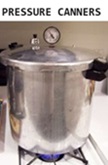
You can make jams, jellies, can fruit, applesauce, salsa and pickles with water bath canners, like this Granite Ware 12-Piece Canner Kit, Jar Rack, Blancher, Colander and 5 piece Canning Tool Set
